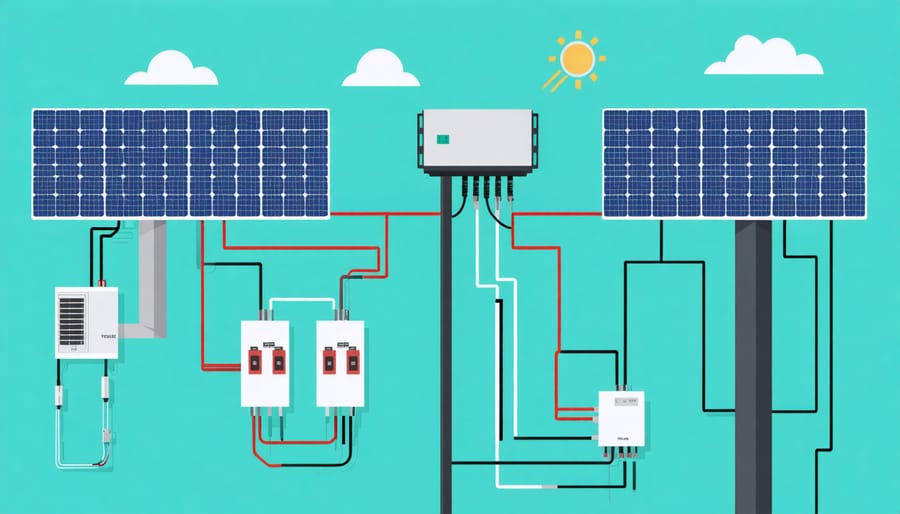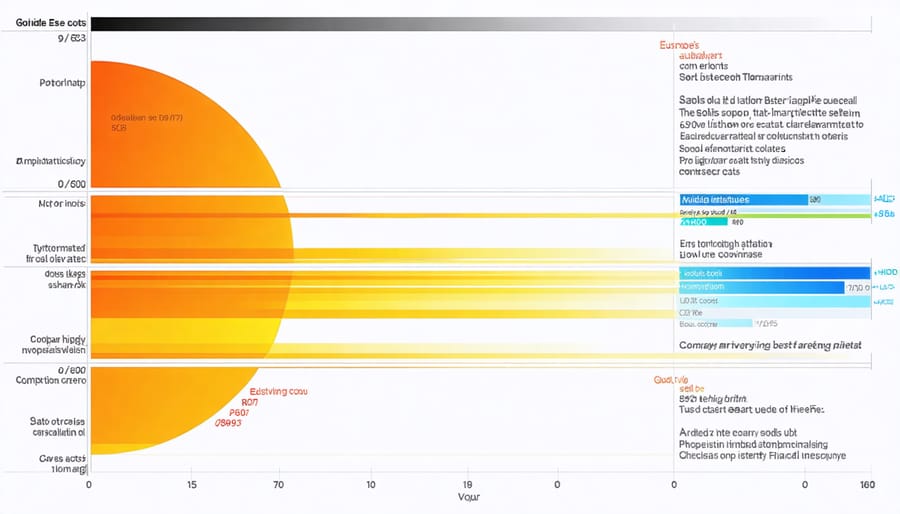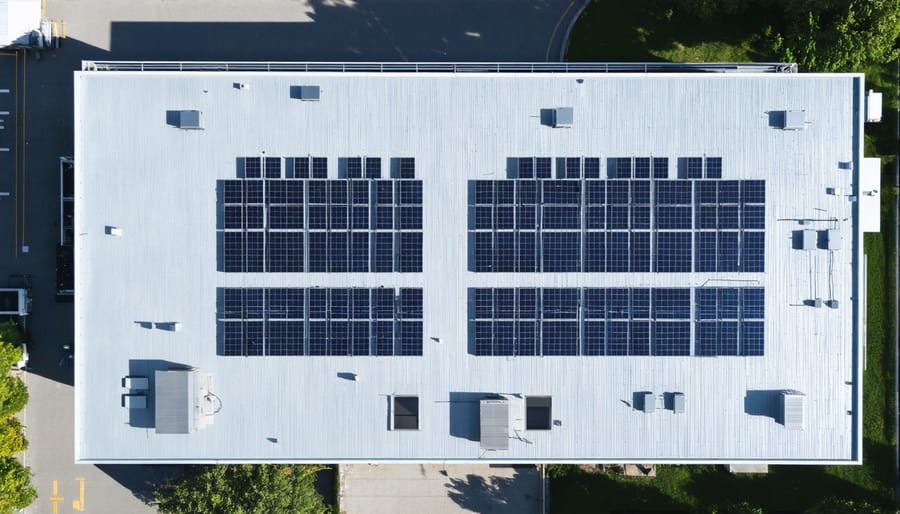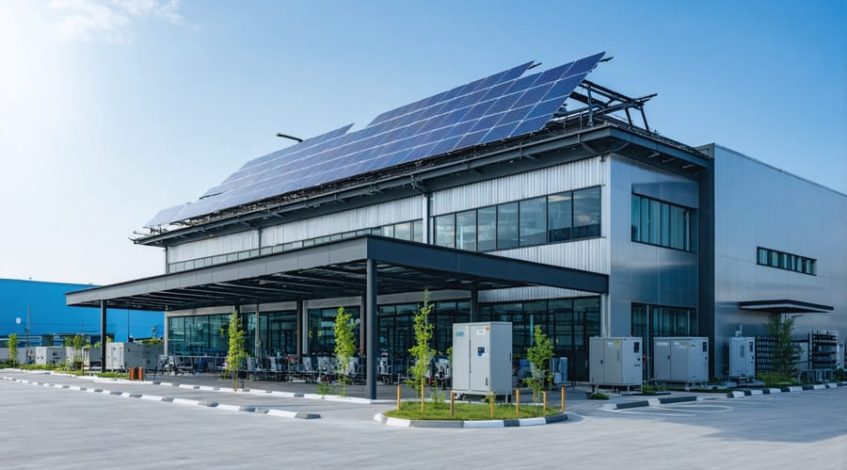Energy independence through solar power represents a transformative shift in how businesses and organizations control their operational costs and environmental impact. Modern hybrid solar systems now enable enterprises to achieve up to 95% energy autonomy, dramatically reducing reliance on traditional grid infrastructure while ensuring uninterrupted power supply.
The convergence of advanced battery storage technology, smart energy management systems, and declining solar panel costs has created an unprecedented opportunity for commercial entities to take control of their energy future. Organizations implementing comprehensive solar solutions are reporting ROI periods of 4-6 years, with some achieving complete energy independence within a decade of implementation.
This strategic investment in solar infrastructure not only shields businesses from rising utility costs but also provides a competitive advantage through predictable energy expenses and enhanced operational resilience. As global energy markets continue to experience volatility, solar independence offers a clear path toward sustainable, self-reliant power generation that aligns with both financial and environmental objectives.
What Makes Hybrid Solar Systems Different

Grid Connection + Battery Storage
Hybrid solar systems combine grid connectivity with battery storage to maximize energy independence while maintaining reliability. These systems intelligently manage power flow between solar panels, batteries, and the grid, ensuring continuous operation during both peak production and nighttime hours. During daylight, excess solar energy charges the batteries while simultaneously powering facilities. When solar production decreases, the system automatically draws from stored energy before accessing grid power.
Modern battery storage solutions, particularly lithium-ion systems, offer significant advantages in terms of capacity, lifespan, and response time. Smart inverters and energy management systems optimize power distribution by analyzing consumption patterns and weather forecasts, automatically switching between power sources to maintain optimal efficiency and cost-effectiveness.
The grid connection serves as a backup power source and enables facilities to participate in net metering programs, where excess energy can be sold back to utilities. This hybrid approach provides the best of both worlds: the independence of off-grid systems with the security of grid access, resulting in enhanced reliability and potential cost savings through peak load reduction and demand response programs.
Smart Energy Management
Modern smart energy management systems form the backbone of efficient solar installations, optimizing power distribution and consumption in real-time. These sophisticated platforms utilize artificial intelligence and machine learning algorithms to predict energy needs, manage storage systems, and balance grid interaction.
The system continuously monitors energy production, consumption patterns, and grid conditions, making instantaneous adjustments to maximize self-consumption of solar power. During peak production hours, excess energy is automatically directed to storage systems or non-critical loads, while during low production periods, the system intelligently draws from stored reserves before accessing grid power.
Advanced features include demand response capabilities, load scheduling, and automated power trading functionalities. For business operations, these systems can shift energy-intensive processes to times of peak solar production, reducing operational costs while maintaining productivity. The integration of weather forecasting data enables proactive energy management, preparing the system for anticipated changes in solar generation.
Many facilities implementing these systems report energy cost reductions of 20-30% within the first year of operation, demonstrating the tangible benefits of intelligent energy management in achieving solar independence.
The Business Case for Energy Independence
Cost Savings and ROI Analysis
Initial investments in solar energy systems typically range from $20,000 to $100,000 for commercial installations, but the long-term financial benefits significantly outweigh these upfront costs. Organizations can expect to recoup their investment within 4-7 years through reduced utility bills and various incentives.
Modern monitoring systems help track your energy savings and optimize system performance, potentially increasing ROI by 15-20%. Businesses can typically reduce their energy costs by 40-75% immediately after installation, with some achieving complete elimination of electricity bills within peak production hours.
Financial benefits include:
– Annual energy savings of $10,000-$50,000 for medium-sized commercial installations
– Federal tax incentives covering up to 30% of installation costs
– Accelerated depreciation benefits
– State-specific renewable energy certificates
– Protection against rising utility rates (historically 2-3% annually)
Additional value comes from increased property values, typically 3-4% higher for buildings with solar installations. Organizations can also benefit from renewable energy credits and carbon offset programs, creating additional revenue streams.
The ROI calculation should consider maintenance costs (approximately 1% of system cost annually) and panel degradation (0.5% per year), but these factors are typically offset by rising energy costs and improved technology efficiency.

Government Incentives and Tax Benefits
The U.S. federal government offers substantial incentives for solar energy adoption, including the Investment Tax Credit (ITC), which currently provides a 30% tax credit on solar system installations through 2032. This significant financial benefit can dramatically reduce the initial investment cost for businesses and organizations pursuing energy independence.
State-level incentives vary by location but often include additional tax credits, rebates, and performance-based incentives. Many states offer Solar Renewable Energy Credits (SRECs), allowing solar system owners to earn revenue by selling credits to utilities that must meet renewable energy requirements.
Organizations can also benefit from accelerated depreciation through the Modified Accelerated Cost Recovery System (MACRS), enabling them to deduct the value of their solar assets over a five-year period. This depreciation schedule significantly improves project economics and returns on investment.
Local utilities frequently provide additional incentives, such as net metering programs that credit excess power generation at retail rates. Some municipalities offer property tax exemptions for solar installations, while others provide streamlined permitting processes and reduced fees.
To maximize available benefits, organizations should:
– Consult with qualified tax professionals familiar with renewable energy incentives
– Research state-specific programs through official energy offices
– Engage with local utilities to understand available programs
– Consider timing installations to optimize incentive availability
– Document all qualifying expenses and maintain proper records for tax purposes
These incentives, when properly leveraged, can reduce payback periods to as little as 3-7 years for many commercial installations.

Real-World Success Stories
Several organizations have successfully achieved solar energy independence, demonstrating the viability and benefits of this sustainable approach. Here are three notable examples that showcase different implementation strategies and outcomes.
The Sierra Nevada Brewing Company in California transformed its energy profile by installing a 2.6-megawatt solar array combined with hydrogen fuel cells and biogas generators. This comprehensive system now provides 100% of their electricity needs, resulting in annual savings of $2.5 million. The brewery achieved complete energy independence within five years of implementation, while maintaining consistent production levels and quality standards.
Adobe Systems’ San Jose headquarters presents another compelling case study. Their three-tower complex utilizes a 2.1-megawatt solar installation integrated with smart building management systems. The project delivered a return on investment in just four years, reducing operational costs by $1.2 million annually. The system’s excess power generation during peak sunlight hours is stored in advanced battery systems, ensuring 24/7 operations without grid dependency.
IKEA’s distribution center in Perryville, Maryland demonstrates the scalability of solar independence. Their 2.7-megawatt rooftop installation, coupled with ground-mounted arrays, generates 4.1 million kilowatt-hours annually. This system not only eliminated their electricity bills but also creates surplus energy that they sell back to the grid, creating an additional revenue stream. The project paid for itself in just over three years and serves as a model for large-scale commercial implementations.
These success stories share common elements: strategic planning, phased implementation, and integration with existing operations. Each organization achieved significant cost reductions while maintaining operational reliability, proving that solar energy independence is both technically feasible and financially advantageous for diverse business types and scales.
Implementation Strategy
System Design and Sizing
Determining the optimal size for your solar energy system requires careful analysis of several key factors. Start by reviewing your facility’s historical energy consumption patterns through utility bills from the past 12-24 months. This baseline data is crucial for designing effective energy independence solutions that match your needs.
Consider your available installation space, whether rooftop or ground-mounted, and factor in any future expansion plans. A comprehensive site assessment should evaluate solar exposure, shading analysis, and structural capabilities. For commercial installations, peak demand periods are particularly important, as they significantly impact system sizing decisions.
Use the following calculation method:
– Daily energy consumption (kWh)
– Solar panel efficiency rating
– Average sun hours in your location
– System losses (typically 15-20%)
– Battery storage requirements
Most commercial systems are sized between 100kW to 500kW, but larger facilities may require megawatt-scale installations. Factor in a 20% buffer for future growth and seasonal variations. Remember that oversizing can lead to unnecessary costs, while undersizing may not achieve your energy independence goals.
Work with certified solar designers to conduct detailed modeling and performance simulations. They can help optimize your system size while considering local regulations, utility policies, and available incentives.
Installation and Integration
Successful implementation of solar energy systems requires careful planning and consideration of several key factors. The installation process begins with a comprehensive site assessment to evaluate solar exposure, structural integrity, and available space. Professional installers should conduct detailed shade analysis and roof load calculations to determine optimal panel placement and mounting requirements.
System sizing is crucial and should be based on historical energy consumption patterns, future growth projections, and desired level of energy independence. Integration with existing electrical infrastructure demands careful coordination between solar contractors and facility engineers to ensure seamless operation and code compliance.
The installation timeline typically spans 4-12 weeks, depending on system size and complexity. Critical components include proper mounting systems, inverter placement, and the establishment of monitoring capabilities. For commercial installations, special attention must be paid to minimizing business disruption during the installation process.
Safety considerations and local building codes play vital roles in implementation. Proper permits, inspections, and utility interconnection agreements must be secured before system activation. It’s essential to work with certified installers who understand local regulations and have experience with similar-scale projects.
Post-installation procedures should include comprehensive system testing, staff training, and the establishment of maintenance protocols. Regular monitoring and preventive maintenance schedules help ensure optimal system performance and longevity, maximizing the return on investment over the system’s lifetime.
The journey toward solar energy independence represents a transformative opportunity for organizations committed to sustainable, cost-effective operations. By embracing solar technology, businesses and institutions can secure their energy future while contributing to environmental sustainability. The demonstrated success of numerous organizations across various sectors proves that energy independence is not just an ambitious goal but an achievable reality.
The benefits of solar energy independence extend far beyond mere cost savings. Organizations gain enhanced operational resilience, protection against utility rate fluctuations, and significant reduction in carbon emissions. The combination of advanced solar technology, storage solutions, and smart energy management systems creates a robust framework for sustainable operations that can adapt to changing energy needs and market conditions.
As we’ve explored throughout this article, the path to energy independence requires careful planning, strategic implementation, and commitment to long-term sustainability goals. However, the return on investment, both financial and environmental, makes this transition increasingly compelling for forward-thinking organizations.
The time to act is now. With favorable government incentives, decreasing technology costs, and proven implementation strategies, organizations have unprecedented opportunities to achieve energy independence. Whether starting with a small-scale installation or implementing a comprehensive energy solution, each step toward solar energy independence positions your organization for future success.
We encourage decision-makers to evaluate their current energy needs, consult with qualified solar providers, and develop a roadmap toward energy independence. The investment in solar energy today will yield returns for decades to come, while establishing your organization as a leader in sustainable business practices.

